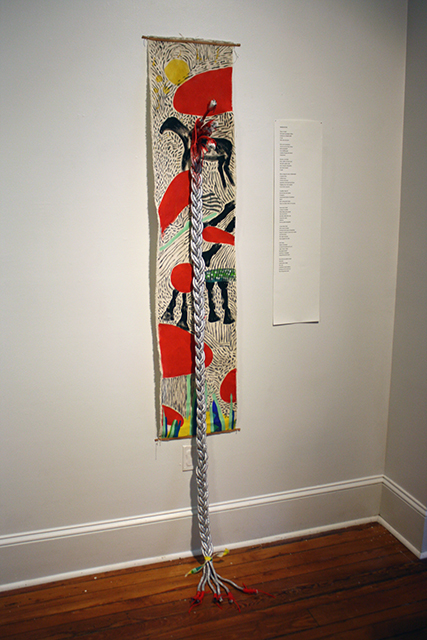
Melissa Godoy Nieto, “Caballos, Cabellas.”
Artscape, Baltimore’s annual, gigantic public art festival, and the Artist-Run Art Fair launch this week. Yesterday, we posted about a few local galleries ahead of time to scope out what’s on view across town from the main festivities. Today, we’re discussing exhibitions from Melissa Godoy Nieto and Lane Harlan at Platform, Colin Foster at Springsteen, and Michael Assiff at First Continent.
Melissa Godoy Nieto & Lane Harlan: Ut Pictura Poesis
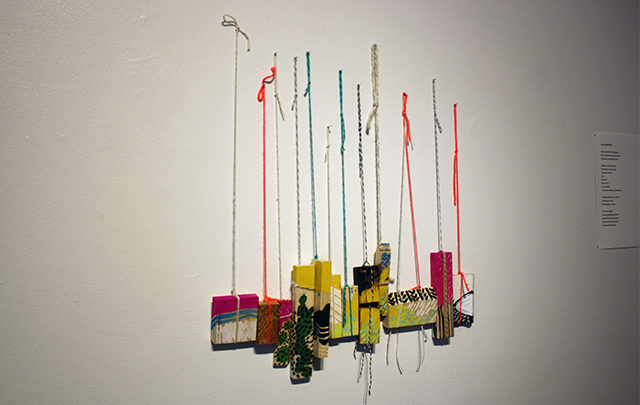
Melissa Godoy Nieto, “Compuestos” at Platform Gallery.
Platform Gallery
116 W. Mulberry St.
Baltimore, MD
July 9 – 30, 2016
What’s on view: A collection of travel poems about Mexico by Lane Harlan and mixed-media work by Melissa Godoy Nieto created in response to Harlan’s poetry. Bright color, fibers, and black illustration-like brushwork dominate. Also, delicious mezcal.
Molly: I was instantly struck by the intimate relationship between Godoy’s visual work and Harlan’s poems. Lately it seems like Mexico on the tip of everyone’s tongue, and getting ready to move to Mexico City myself, this work was really enchanting. There was a strong sense of nostalgia in the air. Lane Harlan’s poems are so seductive. There was a line,
“I squirt lime into your mouth
Watch it dissolve like rain in the saltpeter
(A bob of spit slows itself to the ground)”
That had me feeling like I was making out with someone in Mexico (the mezcal helped too.) I’m really partial to narrative work and the sense of longing in the poems in relation to the symbolic work had me enthralled.
Michael: Are we all thinking wistfully about beloved Mexico because of the looming threat of a wall coming between us? Maybe that’s the case on some level, but Harlan’s poetry mainly reminds us that Mexico is awesome, regardless of the geopolitical spats we’re unwittingly dragged in to. And for the most part, Nieto’s visual works do as well. I’m more attracted to her abstraction-leaning and less illustration-like pieces. The assemblages that incorporate fiber techniques and other non-traditional materials really allow the artist’s strong penchant for compositions and color to shine. They capture a fun, calculated-casual design sensibility that I think can get lost in a few of the more “painting” paintings with fussy, undifferentiated brushstrokes. Standout pieces include “5,” a piece where strings connect a round abstract composition on an irregularly-shaped piece of paper to the corner of stretcher bars on a small plane below. The accompanying poem seems to reference the past five centuries of colonialism and urbanization in Mexico, and there’s a fitting sense of imperfect geometries encapsulating a bit of chaos in this work.
Colin Foster: The Squinter’s Watch
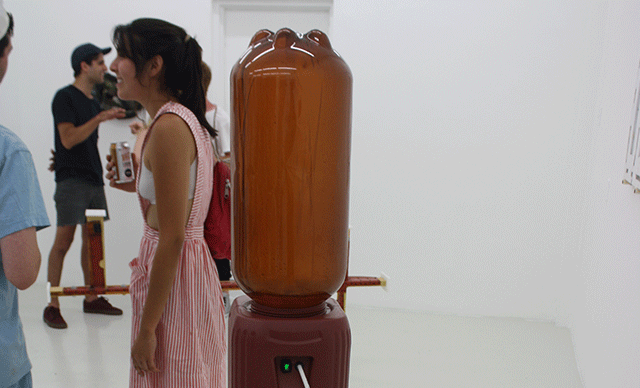
Colin Foster, detail of “Young Plastec Son,” 2016. UHMW, ABS, PP, PVC, Silicone, Custom Electronics, Submersible Pump.
Springsteen
502 W Franklin St.
Baltimore, MD
July 9 – August 6, 2016
What’s on view: An assortment of odd machines, seemingly assembled from found objects. Featuring: a tablet embedded in a pleather lump that plays a game of solitaire by itself, a totem of coolers and water tanks that circulates fluid, and various other contraptions from small wall-mounted works to larger furniture-like assemblages.
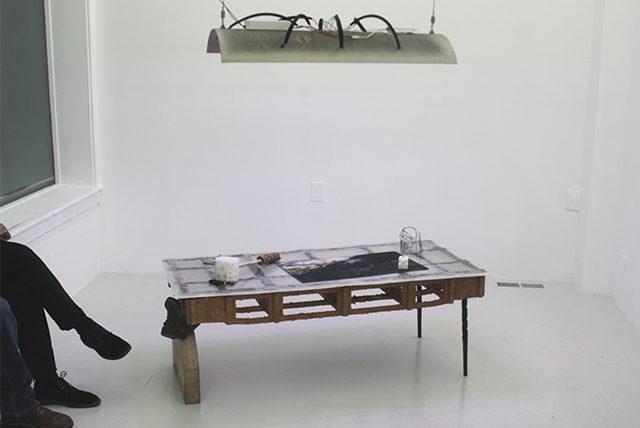
Colin Foster, “Eveninging,” (in collaboration with Colin Van Winkle), 2016 Fiberglass, Epoxy, Enamel, Custom Electronics, Hardware
Molly: I’ve been thinking about the short story posted at the front of Colin Foster’s show for days. A girl in a hot pink mini skirt is trying to save a dragon from the branches of a Juniper tree while a gang of “junk kids” heckle her, only to be engulfed in flames by the dragon she freed. It seemed like a strange retelling of the folklore tale, Juniper Tree, through a #Gamergate lens. After reading Foster’s short story I was immediately drawn to a wall piece resembling the seat of a used leather chair with an inlaid online solitaire game rigged to always win. I was recently put on a #gamergate twitter list for speaking out against #heterosexualprideday. I had a band of gamer bros incessantly heckling me about “straight” pride and tweeting me hentai girls wearing “Make America Great Again” hats to the point I had to shut down my Twitter for a few days. The wall piece felt like an encapsulation of “junk kid” existence, where you’re set up to win but it’s banal, pathetic, and solitary existence.
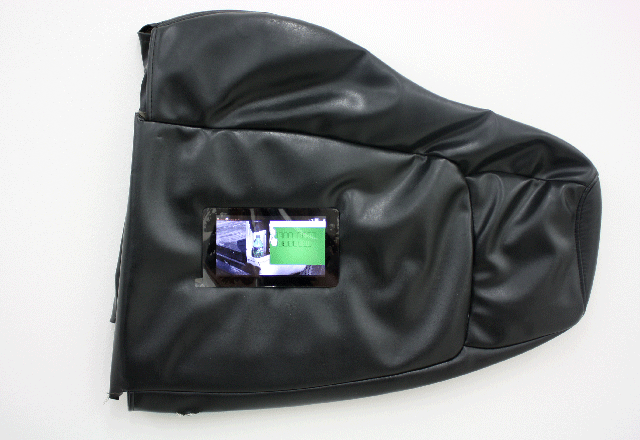
Colin Foster, “The Self-Aware Slug,” 2016, Custom Softwear, Linux Computer, Vinyl.
Michael: I love that you always have such a specific, personal point of reference for artwork that’s also somehow so relevant to what’s going on in mass culture at the time. I would love to see shows through your eyes for a weekend! I think in general you empathize much more than I do, but here I found myself sympathizing with that solitaire piece, “The Self-Aware Slug.” The artist explained that he collaborated with a coder to create a sophisticated program, cycling through games of solitaire endlessly. Apparently the software architecture is capable of solving much more complicated problems, but it’s trapped in this cycle of fulfilling a basic, lame task. There’s a tragicomic element to this pseudo-AI existence, and combined with the vaguely-piano-like, artificial-leather frame, it evokes an android singing the blues in a simulation casino lounge. I don’t think I spent enough time (or had enough background information) with any other piece in the show to feel such an affinity, but I definitely could’ve had I explored more. There’s just so much weird, weird content here. The Squinter’s Watch is what a derelict The Sharper Image would look like in the universe the film adaptation of Johnny Mnemonic is set in.
Michael Assiff: Remediation Flowers

Michael Assiff, “Hyperaccumulators,” plastic on Belgian linen, cotton duck, and army cloth, 2016.
First Continent
500 W. Franklin St.
Baltimore, MD
July 9 – August 21, 2016
What’s on view: A series of monochromatic canvases with textured flower motifs, architectural interventions suggesting fictional fixtures that had been removed from the gallery, grow lamps pointing into holes in the gallery floor.
Molly: Walking into First Continent felt like walking into the ghost of a dentist’s office with… sunflower art. The only way to make a dentist’s office worse is to paint it all white. The sterile environment pulled focus to the intervention into the architecture. I loved little moments where the cracks and voids became works of their own. The residue from where the slop sinks once were became paintings in and of themselves.
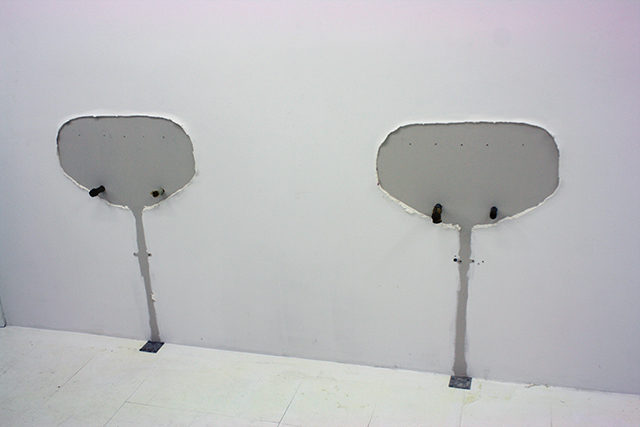
Michael Assiff, “Aesbestos (sinks),” mixed media, 2016.
Michael: One of my favorite things about this show was the promotion. In a few spots around the city, there are these posters with large paragraphs of boilerplate text advertising various services for property owners—phytoremediation of toxic soil, testing for lead, and faux finishing—with the names of the businesses missing and the dates and location for the opening at the bottom. I didn’t have a good idea of what this work would look like, but upon entering the gallery it kind of makes sense. There are allusions to renovation/removal scattered about the space and these paintings that are more like a portable plaster bas relief with a floral motif. I love the suggestion that something like slop sinks had been removed from the space, and that decorative architectural details are somehow being re-inserted through these “paintings”. I think it describes a lot of the weird limbo so much real estate is in as it shifts from one use to another and there’s some sense of provisionality to how we inhabit the city we’re dealt, including all our anxieties over contaminants.


Comments on this entry are closed.